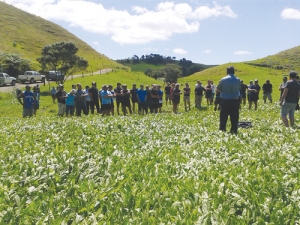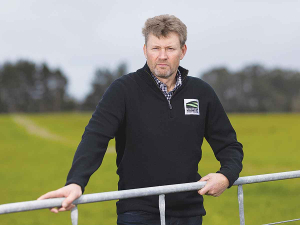But there's still plenty of work to do, says farm consultant Gareth Baynham.
Baynham is facilitator of the Northland partner farm project for DairyNZ and Northland Dairy Development Trust (NDDT) and gave a recent briefing on targets and results on the farms.
Following on from the DairyNZ focus farm of Alister and Lyn Candy (2010-2015), Baynham said they were excited about what happened there and thought they could do something similar at partner farms. Also NDDT was looking for an extension to the principles of its trial farm near Dargaville.
"We've got 'pasture' from Profit from Pasture as our catch cry: it was at our focus farm and we are carrying that through to our partner farms. We want to demonstrate how all farm management, and especially pasture management, can increase profitability."
The two focus farms are run by Tony and Briar Lunjevich at Takahue, near Kaitaia, and Innes Anderson and Tania Dropulich, with contract milkers Philip and Pia Rockell, near Kaiwaka in the lower north.
All the 'heavy lifting' is done by the management team of farmers.
"We meet the farmers and have an initial whole farm assessment using the DairyNZ tool. We meet monthly for six months and then we go to quarterly... a bit different from the focus farm where we meet monthly for three years."
Tony and Briar Lunjevich joined the partner farm progrmme in 2014 with support from a management team who have given their time, and sponsors.
Tony and Briar are 50/50 sharemilking for Don and Linda Lunjevich, Tony's parents. The farm before they started was a 107ha milking platform; Tony had just bought a kikuyu runoff and parts of that are now coming into the milking platform. There's a long walk (2.4km) to the furthest paddock and the contour is challenging in places. Tony had been doing three milkings in two days, with 16 hour milking of 230-240 cows.
The big move was to increase stocking rate. The farm was producing about 580kgMS/ha and 260kgMS/cow which is typical for that area, Baynham said. Pasture was 8tDM/ha and the key goal was to lift that to 10tDM/ha.
The initial plan was to increase equity for Tony and Briar to $500m and lift milk production from a total of 600,000kgMS to 90,000kgMS.
"We were going to do that through pasture management – the feed wedge, spring rotation plan, rotation length targets, a nitrogen plan and good use of supplement when it is profitable to use it," he said.
They planned to increase the 240 cows to nearly 300. Over time they planned to bring forward the calving date from July 25 to July 10.
Another target was to reduce whole farm expenditure, not just the sharemilker, to $3/kgMS.
"They were running a pretty tight ship and we needed to keep it tight. They also wanted to move to twice-a-day milking."
In year one milk production ended about 673kgMS/ha up so "that was a bit of a win". "There was good early season stuff but we really fell away in late lactation. Pasture eaten went from 8t to 9.2t – again a good win but 10 was our three-year target."
The spring rotation and farm walks worked well but pasture quality suffered in spring and autumn. Reproduction at 39% six week in-calf rate was pretty disappointing (78% is the industry target).
"Based on that result we came up with a plan. This was a good lesson to learn. We thought we wanted more days in milk and we'd do that by calving five days earlier. What we should have done – LIC pointed out to us – was tighten up the calving; that would have given us the same effect."
Lameness was a major issue.
Baynham said so far this year (2015-16) there have been big changes. Land area has increased to 124ha, some of the runoff is being milked off. The stocking rate is 2.4 cows/ha and 14ha of chicory was grown for high value feed through the summer.
Milk production is on track for 84,000kgMS – up on 72,000kgMS last year and 62,000kgMS the year before. This is about 700kgMS/ha so "not a disaster but not quite where we were trying to get to," Baynham said.
All the cows were on 16 hours and 36% were first calvers.
With pasture management there was low cover in the spring and mulching continued too late in May last year.
"That was a massive concern that put the farm under pressure all year. The big focus this year will be getting the mulching done earlier."
Reproduction this year was 41% six-week in calf rate. "That was really disappointing: we hoped to pick up some gains from the three milkings in two days. Cow condition was a bit light so that is a big focus for us next year."
Summing up this year, he said they had had a good peak right on target then pasture quality bit during summer and autumn.
The first year they milked twice a day, this year three times in two days.
"It didn't quite peak as high but that drop-off has been a lot lower this year through aggressive pasture management."
By moving to 16 hours, when a worker quit they were able to get away with not replacing him.
Tactical OAD milking helps cow condition
The Lower North Island partner farm is run by Innes Anderson and Tania Dropulich, with contract milkers Philip and Pia Rockell, and once again supported by a great management team and local sponsors. Innes and Tania lease the farm from Innes' parents.
There's a 211ha milking platform: "That's what happens when you GPS your farm – it shrinks; it was 220ha, all our numbers were based on that," Baynham says.
The farm has 140ha irrigated. Before the partnership started they were milking 470 cows (2.2cows/ha) doing 160,000-170,000kgMS. That was probably a fraction above average for the area. That equated to 780kgMS/ha or 315kgMS/cow.
Pasture and crop eaten was just under 10t DM/ha and the goal is 11.4t DM/ha by 2017-18. "We wanted to increase the surplus by $180,000 and that would come from producing another 30,000kgMS and holding costs.
"It was a good worthwhile plan; it was going to come from pasture management, spring rotation plan, rotation length targets, nitrogen. Nothing is new there, but those are some great tools.
"They planned to oversow and mulch annual rye into kikuyu – that's worked really well for them."
They planned to lift the stocking rate from 2.2 to 2.6 cows/ha and hold farm expenditure at $700,000 so the increase in milk should dilute the costs from $4.24/kgMS to about $3.50/kgMS.
"That is going to come from Tania being mean and stingy when she is budgeting and we are helping her out with that," said Baynham.
"We on track for about 900kgMS/ha which will be about 190,000kgMS, up from about 160,000kgMS last year. Tactical once-a-day is being used to manage cow conditions and feed deficits.
"We are pleased with the milk production gains: 30% of the herd are first calvers and quite a bit of the milk went out of the vat for [beef] calf rearing.
"The negatives have been that feed deficits have had a bit of an impact on production.
"Pasture was low at calving: Philip used the spring rotation plan well but we found at the higher stocking rate the margin of error [is thin] and you have to respond quickly to deficits.
"Last time I checked the financials were tracking to about $3.80/kgMS. So we've got work still to do there. The big goal there is to use the grass we grow.
"The management team are excited about the milk production and a few of them are thinking maybe we didn't set the targets quite high enough for year three."
A couple of feed deficits occurred.
"Year one is a tough learning curve for everyone."
The team had done a great job "but we are all thinking there is room to make milk production a lot better next year."


















